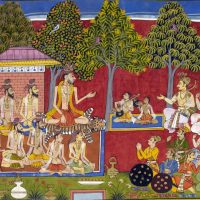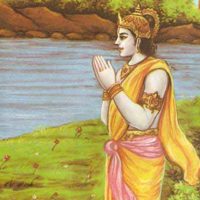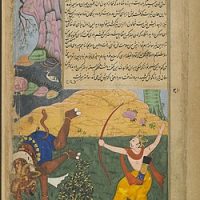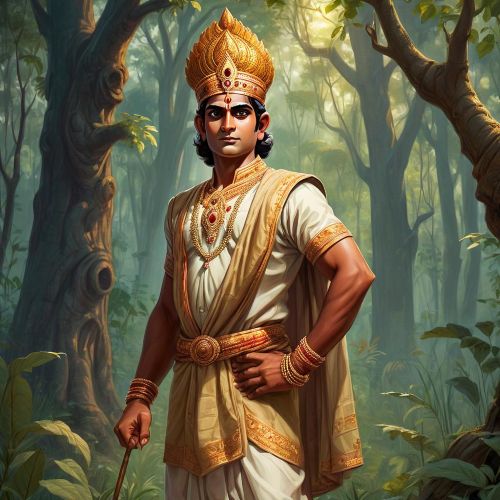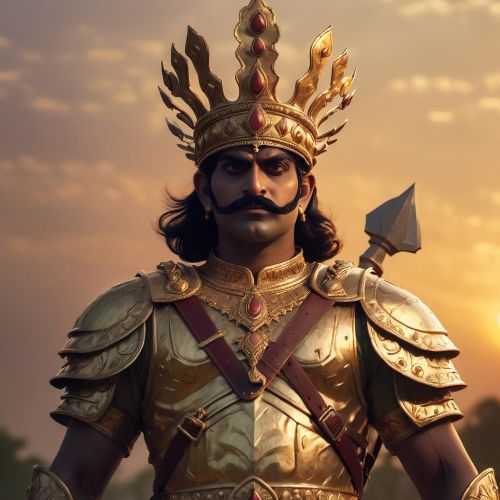
Shatrughna : The Unsung Brother
Listen
At a glance
| Description | |
|---|---|
| Origin | Indian Mythology |
| Classification | Mortals |
| Family Members | Dasharatha (Father), Kaikeyi (Mother), Rama, Lakshmana, Bharatha (Brothers) |
| Region | India |
| Associated With | Royalty, Duty |
Shatrughna
Introduction
In the vast narrative of the Ramayana, Shatrughna often stands quietly beside his more celebrated brothers—Rama, Lakshmana, and Bharata. Yet, his story carries deep significance within Hindu mythology. The very meaning of his name, “destroyer of enemies,” reflects his courage and purpose. As the youngest son of King Dasharatha and Queen Sumitra, and the earthly embodiment of Vishnu’s Sudarshana Chakra, Shatrughna represents divine precision, loyalty, and service. His life, though less spotlighted, embodies the essence of silent strength – acting dutifully without seeking glory.
Physical Traits
Ancient scriptures and temple art describe Shatrughna as a prince of striking grace and strength. As Lakshmana’s twin, he shares similar physical traits, broad shoulders, radiant complexion, and sharp eyes that reveal both alertness and calm. He is often shown carrying a bow or sword, symbols of his warrior heritage and commitment to dharma. Unlike the fiery intensity of Lakshmana or the regal presence of Rama, Shatrughna’s demeanor is serene and composed, symbolizing balance and quiet determination. His appearance reflects both royal dignity and inner discipline, emphasizing that true power often resides in calm composure.
Family
Shatrughna’s lineage is deeply woven into the royal family of Ayodhya. Born to Sumitra, he shares a twin bond with Lakshmana that mirrors the close relationship between their elder brothers Rama and Bharata. While Lakshmana devoted himself entirely to Rama during his exile, Shatrughna remained steadfast by Bharata’s side, helping maintain Ayodhya in their brothers’ absence. His marriage to Shrutakirti, daughter of King Kushadhvaja and cousin to Sita, further strengthened the familial alliances within the Ramayana’s divine narrative. Together, they had two sons, Subahu and Shatrughati, who continued the noble lineage. His devotion to family was unwavering, whether as a brother, husband, or father, Shatrughna upheld his responsibilities with humility and care.
Other names
Throughout various retellings and scriptures, Shatrughna is known by multiple names that capture different aspects of his character. He is called Ripudaman, meaning “conqueror of foes,” and Shatrughati, a title emphasizing his victory over evil forces. In devotional contexts, he is referred to as Sumitranandan, the beloved son of Queen Sumitra, a name that reflects his deep familial devotion. In some texts and inscriptions, regional variations such as Satrugna or Shatrugna appear, each preserving his identity across India’s diverse storytelling traditions. These names together portray a man whose life was defined by courage, service, and unwavering adherence to dharma.
Powers and Abilities
As the mortal incarnation of Vishnu’s Sudarshana Chakra, Shatrughna possesses both divine might and human wisdom. His martial abilities are legendary, yet his greatest strength lies in his disciplined approach to duty. His most renowned feat is the slaying of Lavanasura, a fearsome demon and descendant of the rakshasa king Madhu. Lavanasura’s tyranny had brought suffering to the people of Madhupura (identified with modern-day Mathura). Empowered by Rama’s blessings and wielding divine weapons, Shatrughna faced the demon in fierce combat, ultimately destroying him and restoring peace to the land. This victory not only showcased his valor but also his sense of justice and purpose.
Beyond the battlefield, Shatrughna demonstrated exceptional administrative skill. When Rama went into exile and Bharata refused to ascend the throne, it was Shatrughna who maintained the governance of Ayodhya. His leadership ensured that the kingdom remained stable during years of uncertainty. His ability to balance power with humility and duty with compassion made him a model of righteous governance. In every action, Shatrughna exemplified nishkama karma, selfless action performed without desire for personal reward.
Modern Day Influence
Though not as prominently featured as Rama or Hanuman in popular culture, Shatrughna’s influence endures in subtle yet meaningful ways. His devotion and humility are celebrated in temple traditions and local legends, especially in northern India. The Shatrughna Temple in Rishikesh is one of the few shrines dedicated solely to him, symbolizing the spiritual recognition of his role in the divine order. Pilgrims visit this temple seeking inner peace and the strength to serve selflessly, virtues that Shatrughna himself embodied.
In literature, television adaptations, and theatrical performances of the Ramayana, Shatrughna’s portrayal has evolved to highlight the importance of supportive strength, the kind that uplifts others without seeking recognition. Modern reinterpretations often depict him as the ideal brother who upholds the family’s honor and unity through quiet dedication.
His story also finds resonance in philosophical discussions about humility and service. Scholars and spiritual teachers often cite Shatrughna as an example of how true leadership lies not in dominance but in duty and discipline. In a world that often glorifies visibility, Shatrughna’s legacy reminds us of the nobility of silent contribution, the kind that sustains great endeavors without demanding acknowledgment.
Related Images
Source
Chandra, K. R. (Year). Paumacariya (Critical Study). [Book reference]
Griffith, R. T. H. (Trans.). (Year). The Ramayana of Valmiki. [Book reference]
“Shatrughna.” (n.d.). In Wikipedia. Retrieved October 12, 2025, from https://en.wikipedia.org/wiki/Shatrughna
“Shatrughna: Significance and symbolism.” (2025). WisdomLib. Retrieved from https://www.wisdomlib.org/concept/shatrughna
“Shatrughna- The story of Prabhu Ram’s youngest brother.” (2023). HinduPost. Retrieved from https://hindupost.in/dharma-religion/the-story-of-shatrughna/
“Shatrughna, the founder of Mathura.” (n.d.). DieHardIndian. Retrieved from https://diehardindian.com/shatrughna-the-founder-of-mathura/
“4 Different Names of Shatrughana and Stories Associated.” (2024). Lifestalker. Retrieved from https://www.lifestalker.com/2024/10/4-different-names-of-shatrughana.html
World Mythos. (2024). “Shatrughna.” Retrieved from https://worldmythos.com/shatrughna/
Frequently Asked Questions
What is lorem Ipsum?
I am text block. Click edit button to change this text. Lorem ipsum dolor sit amet, consectetur adipiscing elit. Ut elit tellus, luctus nec ullamcorper mattis, pulvinar dapibus leo.
What is lorem Ipsum?
I am text block. Click edit button to change this text. Lorem ipsum dolor sit amet, consectetur adipiscing elit. Ut elit tellus, luctus nec ullamcorper mattis, pulvinar dapibus leo.
What is lorem Ipsum?
I am text block. Click edit button to change this text. Lorem ipsum dolor sit amet, consectetur adipiscing elit. Ut elit tellus, luctus nec ullamcorper mattis, pulvinar dapibus leo.
What is lorem Ipsum?
I am text block. Click edit button to change this text. Lorem ipsum dolor sit amet, consectetur adipiscing elit. Ut elit tellus, luctus nec ullamcorper mattis, pulvinar dapibus leo.
What is lorem Ipsum?
I am text block. Click edit button to change this text. Lorem ipsum dolor sit amet, consectetur adipiscing elit. Ut elit tellus, luctus nec ullamcorper mattis, pulvinar dapibus leo.



